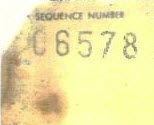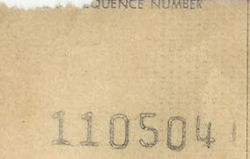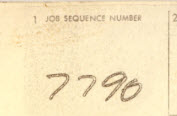Reading 1970 Chevelle Build Sheets
Blocks 1 through 41
I'm working on a CD of information that will break down build sheet information on 1970 build sheets based on quite a collection of these sheets. Primarily it will include Atlanta, Baltimore, and Kansas City with some information on Van Nuys as well. Watch for it!
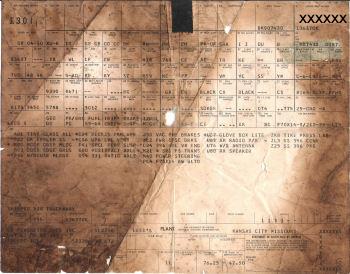 Broadcast
Copy sheets, commonly called 'build sheets', are paperwork that accompanied
a vehicle as it was being assembled showing what components were to
be used during construction. These were not meant to be left in the
car once they were no longer needed at a particular workstation, but
rather collected and tossed in the trash once they served their purpose
or removed at the end of assembly by final inspectors along with anything
else that didn't belong in the car.
Broadcast
Copy sheets, commonly called 'build sheets', are paperwork that accompanied
a vehicle as it was being assembled showing what components were to
be used during construction. These were not meant to be left in the
car once they were no longer needed at a particular workstation, but
rather collected and tossed in the trash once they served their purpose
or removed at the end of assembly by final inspectors along with anything
else that didn't belong in the car.
I can't stress this enough; it is important to note that not all plants were the same when it came to how information was included on these build sheets. Although most of the blocks of data contain the same broadcast code (letters or numbers) for the same item from plant to plant, there are variations. Even the RPO wording in block 107 will vary from plant to plant for the same RPO and attention to these details is generally what separates an authentic build sheet from a reproduction.
I have intentionally omitted some details about some of these differences and used an asterisk (*) character to indicate there are differences. So anytime a question is asked about a particular broadcast code, the assembly plant must be taken into consideration. All explanations and examples are based on build sheets I have readable images of, both genuine and fake.
Atlanta and Kansas City build sheets list origin as Lakewood and Leeds as the plants, respectively, this site still refers to them as Atlanta and Kansas City.
Any questions concerning your build sheet can be addressed to me at . Be sure to include the assembly plant and as many specifics about the car that you know. A readable scan or photo of the build sheet in question will also be helpful.
A typical 1970 Chevelle build sheet for a U.S.-built Chevelle has 108 blocks of data pertaining to the assembly of the car. Not all plants used the same build sheet form, some data blocks differ.
All broadcast codes are determined by parts overall required to build it and one option may require different supporting pieces. For example, a Chevelle equipped with A/C and/or power steering would require different brackets, pulleys, etc. from a non A/C or non power steering car.
I have NO good examples of a Flint, MI. sheet so that plant is omitted in the table below due to lack of data. The blocks are generally broken down as follows.
Block #107 where options are listed is broken down into 5 (five)
columns for data. Each of the 5 columns has a specific set of
possible options; meaning, for example, the first column may only
contain RPO codes beginning with Axx or Bxx, the second column
contains RPO codes beginning with Cxx through Gxx or Cxx through
Jxx, and so on for each column. Each column also has a set width of
18 characters for the RPO code and its description IF there is an
option in the same line in the next column. If there is no
option listed on the same line in the next column, the width is
expanded to 20 characters. For example, if the second column
contains the option listing for the hood and deck stripes on the 5th
line, it may be shown as D88 HOOD&DECK STRIP if there is no option
listed on the 5th line in the 3rd column. If there is an
option listed on the 5th line in the 3rd column the code is
truncated to D88 HOOD&DECK STR.
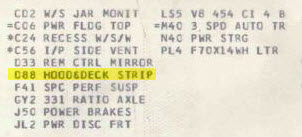
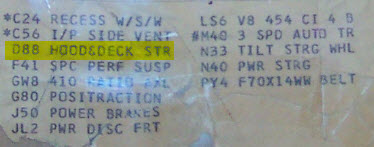
There are several examples from different plants of this holding
true.
Where there are variations in the way data are depicted in a block, those will be shown with 'variation #1', 'variation #2', etc. Contact me for specifics and be sure to be specific about the block number and the assembly plant.
Blocks 1 through 41 -- Blocks 42 through 80 -- Blocks 81 through 123
| Block No. | Label & Information | ||||||||||||||||||||
| 1 | JOB SEQUENCE NUMBER
~ Internal plant data processing number to track assembly. This
block can be blank (empty) or have an alphanumeric entry anywhere
from 4 to 13 characters in length. Arlington ~ variation #1 - 5-digit stamped number Atlanta ~ variation #2 - blank or 13 alpha-numeric typed characters depending on copy Baltimore ~ variation #3 - 6-digit stamped number Kansas City ~ variation #4 - 4-digit stamped number Van Nuys ~ variation #5 - 4-digit hand written number |
||||||||||||||||||||
| 2 | DATE PRODUCED ~ (Arlington, Baltimore, & Kansas City) This block is usually left blank, however entries at Arlington have been noted with a 13 character alphanumeric similar in nature to the character set found on Atlanta sheets in block 1. | ||||||||||||||||||||
| 2 | IGN KEY ~ (Van Nuys & Atlanta) Usually blank. | ||||||||||||||||||||
| 3 | IGN KEY ~ (Arlington, Baltimore, & Kansas City) Usually blank. | ||||||||||||||||||||
| 3 | COMP KEY ~ (Van Nuys & Atlanta) Usually blank. | ||||||||||||||||||||
| 4 | COMP KEY ~ (Arlington, Baltimore, & Kansas City). Usually blank. | ||||||||||||||||||||
| 4 | ENGINE NO ~ (Van Nuys & Atlanta) Usually blank. | ||||||||||||||||||||
| 5 | ENGINE NO ~ (Arlington, Baltimore, & Kansas City). Usually blank. | ||||||||||||||||||||
| 5 | TRANSMISSION NO ~ (Van Nuys & Atlanta) Usually blank. | ||||||||||||||||||||
| 6 | AXLE NO ~ Usually blank. | ||||||||||||||||||||
| 7 | CARB NO ~ (Van Nuys & Atlanta) Usually blank. | ||||||||||||||||||||
| 7 | TRANSMISSION NO ~ (Arlington, Baltimore, & Kansas City). Usually blank. | ||||||||||||||||||||
| 7A | DATE PRODUCED ~ (Van Nuys & Atlanta) Usually blank. | ||||||||||||||||||||
| 7A | CARB NO ~ (Arlington, Baltimore, & Kansas City). Usually blank. | ||||||||||||||||||||
| 8 | BODY NUMBER
~ Fisher Body number. Arlington ~ Top of block - Includes 'BT' plant prefix the same as the trim tag. Atlanta ~ Bottom of block - Includes 'AT' plant prefix where trim tag only indicates 'A' Baltimore ~ Bottom of block - Includes 'BB' plant prefix where trim tag only indicates 'B'. Variation #1. Kansas City ~ Bottom of block - Includes 'BK' plant prefix where trim tag indicates 'KAN'. Variation #2. Van Nuys ~ Top of block. Includes 'BL' plant prefix the same as the trim tag. |
||||||||||||||||||||
| 9 | VEHICLE IDENT NUMBER
~ Six-digit
plant sequence number for the vehicle.
Baltimore is often in block 8 or spread between blocks 8 and
9. Arlington, Baltimore, & Kansas City's 6 digit sequence number is the same font as the job sequence number found in block #1. Atlanta used a unique to Atlanta font for the sequence number and there is no data processing number of any kind stamped in block #1. Van Nuys used a unique to Van Nuys font for the sequence number and has a 4-digit data processing number hand written in block #1. In all cases, the series/model/year/plant character sequence (e.g., 136370A) is the same font as the remainder of data on build sheet. Occasionally the sequence number will get printed either in block 8 or will span blocks 8 and 9 indicating this number was printed either before or after the majority of the build sheet data.
|
||||||||||||||||||||
| 10 | SCHED NO DATE
~ The significance of the SCHED number is dependent upon the
plant; the date is the scheduled date for the car's assembly
to begin. The data are presented in one of five formats. Arlington ~ variation #1 samples 01-0257 & 05-0361 Atlanta ~ variation #2 samples 89 02-16 & 92 02-19 Baltimore ~ variation #3 samples 04 02-02 & 21 02-25 Kansas City(1) ~ variation #4 samples 08 02-11 & 09 04-14 Van Nuys(2) ~ variation #5 samples 18 09-18 & 31 03-31 |
||||||||||||||||||||
| 11 | FRAME ~
Coded frame type (XU for coupe, XV for convertible, XT for sedan,
XX for sedan pickup, XS for Monte Carlo, etc.). There are 3
variations depending on assembly plant. Arlington & Baltimore - variation #1 Atlanta & Kansas City - variation #2 Van Nuys - variation #3 |
||||||||||||||||||||
| 12 | STRG KNUCKLE ~ Code will vary depending on engine type and whether power steering is ordered. | ||||||||||||||||||||
| 13 | FRT. SPRING ~ Code will vary depending on overall car weight and ride height requirements based on options. Code is shown as a double 2-letter code such as 'AQ AQ'. | ||||||||||||||||||||
| 14 | REAR SPRING ~ Code will vary depending on overall car weight and ride height requirements based on options. Code is shown as a double 2-letter code such as 'BE BE'. | ||||||||||||||||||||
| 15 | FRT. SHOCK ~ Code will vary depending on overall car weight and ride height requirements based on options. Code is shown as a single 2-letter code such as 'TA.' Van Nuys changed this code to a double two-letter code separated by a hyphen on December 16. (I have two 12-16 Van Nuys sheets, one with a single two-letter code and one with a double two-letter code. | ||||||||||||||||||||
| 16 | REAR SHOCK ~ Code will vary depending on overall car weight and ride height requirements based on options. Code is shown as a single 2-letter code such as 'AW' and followed by three hyphens with the exception of the Arlington plant where only a 2-letter code is used. El Caminos have a 4-letter code due to the air shocks. | ||||||||||||||||||||
| 17 | STAB. BAR ~ Code will vary depending on overall car weight and ride height requirements based on options. Arlington, Baltimore, & Kansas City use a single 2-letter code such as 'OE' where Atlanta and Van Nuys have a hyphen and a 3rd letter such as "HH-M." | ||||||||||||||||||||
| 18 | CARB ~
Atlanta, Arlington & Kansas City - variation #1. Baltimore - variation #2. Van Nuys - variation #3. |
||||||||||||||||||||
| 19 | PROP SHAFT ~ Representation of painted stripes on drive shaft. Most engine and transmission combinations required a different prop shaft (a.k.a. drive shaft) whether it was due to length, u-joint combinations, etc. Generally dual 2-letter codes separated by a hyphen such as 'PK-OR' except Baltimore. Many drive shafts actually have 3 stripes; it's known 396 & 454 drive shafts do with the 3rd stripe being orange. Whether orange is common to other engines isn't known and could physically identify a 396 or 454 drive shaft to the worker who would then only need to look at the two colors depicted on the build sheet to determine the correct drive shaft. | ||||||||||||||||||||
| 20 | EXHAUST ~ Code will vary for exhaust manifold depending on engine. Some engines at some plants have a 2-letter code and some have a 3-letter code. | ||||||||||||||||||||
| 21 | FAN CLUTCH ~ Either a 2-letter, 3-letter, or 4 digit code depending on other options, such as 'I Z', 'V CH', or '92 10' depending on plant and/or options. | ||||||||||||||||||||
| 22 | FAN PULLEY ~ 2-letter code depending on engine and options. | ||||||||||||||||||||
| 23 | VAC FITTINGS ~ Single letter or 3-digit code depending on engine, options, and plant. | ||||||||||||||||||||
| 24 | DP SEQ NUMBER (data processing sequence) ~ May consist of a 6-digit number alone, a combination of a 6-digit number and a 4-digit number, or a 6-digit number plus a 2-digit number followed by a 4-digit number and will vary depending on the plant and date. Some plants will also have part of these numbers stamped on the trim tag in varying degrees. Four variations for the use of numbers in this block. These are strictly internal, GM data processing numbers and have nothing to do with any options the car may be ordered with. | ||||||||||||||||||||
| 25 | MODEL ~ Consists of the 5-digit series/model number of the vehicle; such as 13637, 13667, 13680, etc. | ||||||||||||||||||||
| 26 | TOP ~ If the vehicle is (1) two-tone, (2) convertible, or (3) is equipped with a vinyl top, a 3-letter code is used to depict the top color such as BLU for blue, BLK for black, WHT for white, GRN for green, and GLD for gold. If the car is a solid color top and bottom, the box will have 3 hyphens (---). | ||||||||||||||||||||
| 27 | ENG (engine) ~ Contains the last two characters of the engine suffix ID code. Baltimore has a variation. | ||||||||||||||||||||
| 28 | TRANS ~
Transmission code with variations. Arlington, Atlanta, Kansas City, & Van Nuys - variation #1 Baltimore - variation #2 |
||||||||||||||||||||
| 29 | AXLE ~ A 2-letter code that matches suffix ID. | ||||||||||||||||||||
| 30 | ALTER ~ A 2-letter code depending on options. | ||||||||||||||||||||
| 31 | ALTER PULLEY ~ All examples to date have 3 hyphens as the pulley was normally part of the alternator assembly. | ||||||||||||||||||||
| 32 | START MOTOR ~ 3-number code for appropriate starter motor assembly. | ||||||||||||||||||||
| 33 | FUEL PUMP ~ 3-number code for appropriate fuel pump. Codes vary from plant to plant. | ||||||||||||||||||||
| 34 | POWER STRG PULLEY ~ 2-letter code for appropriate pulley if applicable. | ||||||||||||||||||||
| 35 | CRANK PULLEY ~ 2-letter code for appropriate pulley. | ||||||||||||||||||||
| 36 | V BELT GROOVE 1 ~ 2-letter code for appropriate pulley as applicable. | ||||||||||||||||||||
| 37 | V BELT GROOVE 2 ~ 2-letter code for appropriate pulley as applicable. | ||||||||||||||||||||
| 38 | V BELT GROOVE 3 ~ 2-letter code for appropriate pulley as applicable. | ||||||||||||||||||||
| 39 | V BELT GROOVE 4 ~ 2-letter code for appropriate pulley as applicable. Van Nuys variation. | ||||||||||||||||||||
| 40 | AIR PUMP & PLUG ~ TCS-x (where 'x' is a number) when applicable. Numerous variations. | ||||||||||||||||||||
| 41 | AIR PULLEY ~ Multiple variations among plants. | ||||||||||||||||||||
Blocks 1 through 41 -- Blocks 42 through 80 -- Blocks 81 through 123
[ Back to Build Sheets ]
TRIVIA FOR THIS PAGE
The logic of some of the block information defies a rational explanation. Below are some examples.
(1) The SCHED NO DATE for Kansas City is formatted as the workday of the month, the month and date. For example 01 02-02 means the 1st work day of the calendar month (01), the month (02) and date (02); February 2, 1970 (Friday) was the first work day in February, 1970. The date 09 04-14 means April 14 (04-14) was the 9th workday of April 19 70.
(2) The SCHED NO DATE for Van Nuys is formatted as the date of the month, the month and date. For example 18 09-18 is 18th calendar day of September 18, 1969 & 31 03-31 is the 31st calendar day of March 19 70. Why the calendar date is repeated is not known.

 Home
Home Decode
Decode Tech
Tech Tools
Tools Dale's Coins/CDs
Dale's Coins/CDs Contact
Contact Chevelle
of the Month
Chevelle
of the Month Things
For Sale
Things
For Sale Custom
Stickers
Custom
Stickers
